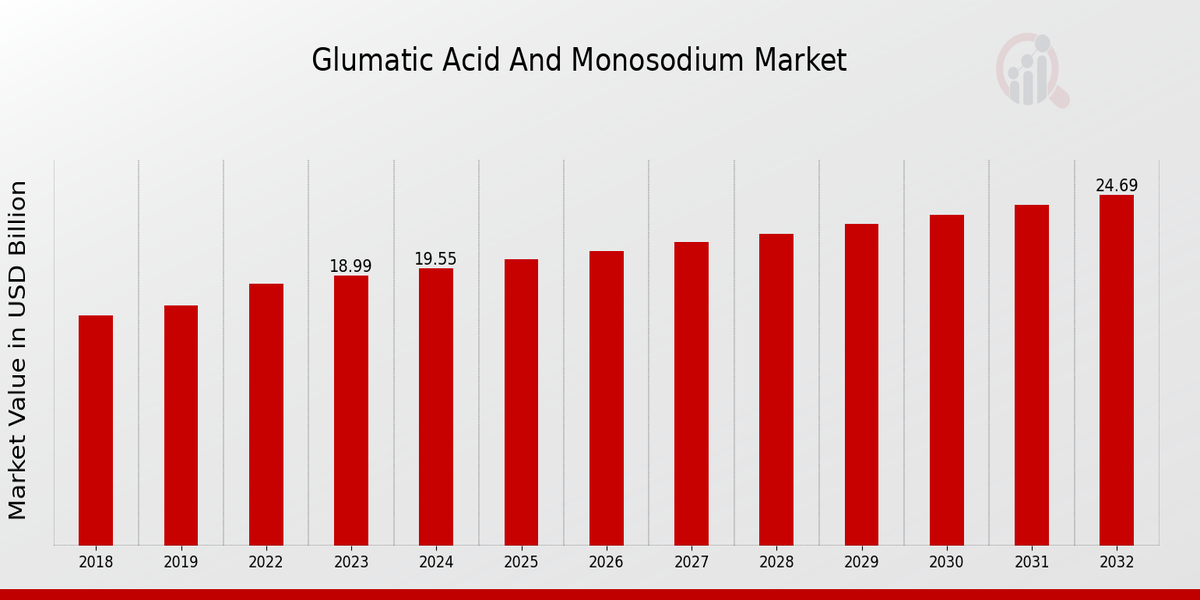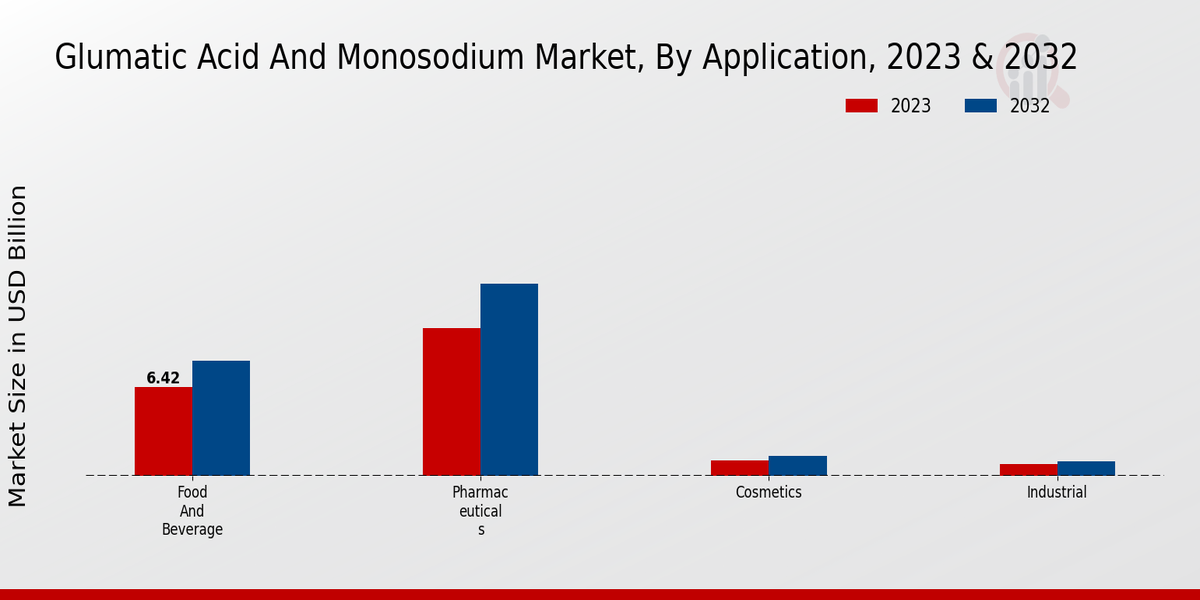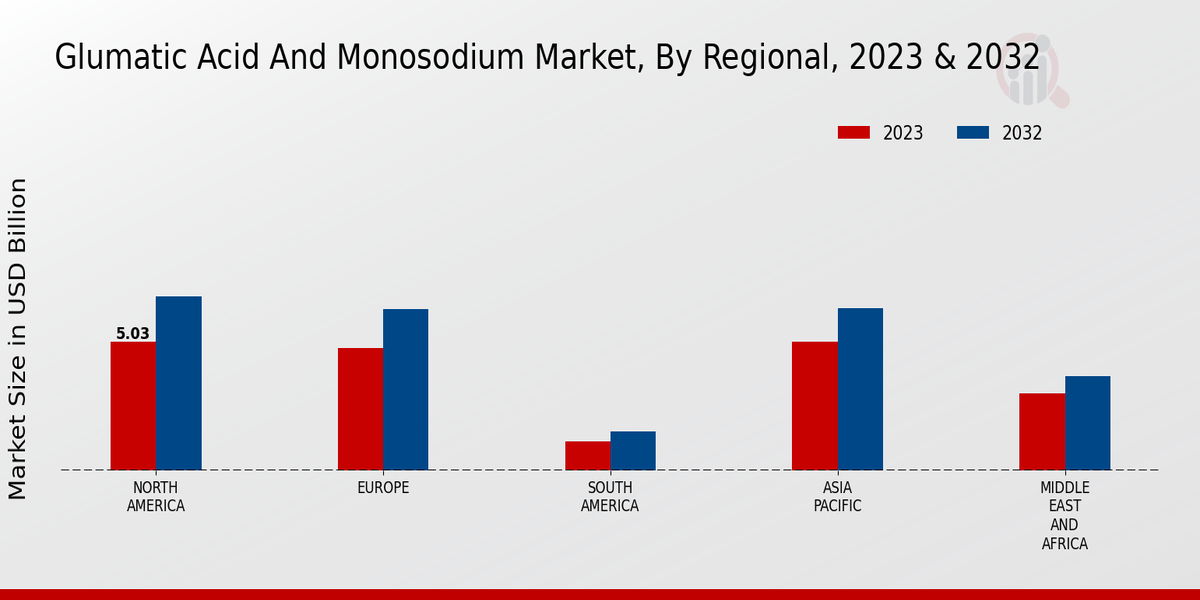Global Glumatic Acid and Monosodium Market Overview
The Glumatic Acid and Monosodium market size was estimated at 20.14(USD Billion) in 2024. The Glumatic Acid and Monosodium Market Industry is expected to grow from 20.74(USD Billion) in 2025 to 26.96(USD Billion) by 2034. The Glumatic Acid and Monosodium MarketCAGR (growth rate) is expected to be around 3.00% during the forecast period (2025 - 2034).
Key Glumatic Acid and Monosodium Market Trends Highlighted
One of the trends impacting the glutamic acid and the MSG market globally is Highlighted. The main market drivers include the increasing consumption rates of food, including umami and savory flavors, due to the consumer preference towards processed and convenience food products. The rapidly growing foodservice market and emerging economies expansion, in turn also creates utility for MSG and glutamic acid.Market opportunities involve the development of new products that consumers are looking for in the form of natural and organic MSG substitutes. New flavors and improving existing flavors through R&D are also meeting the needs of the manufacturers.Current trends in the commodity glutamic acid and the MSG market include the use of fermentation technology in the commercial production of MSG, whose production is cost-effective and environmentally friendly. In addition, the an increase in the number of manufacturers adopting clean labels and transparency. This also encourages the use of natural and non-GMO ingredients, which are changing the competitive environment of the industry.
Source: Primary Research, Secondary Research, MRFR Database and Analyst Review
Glumatic Acid and Monosodium Market Drivers
Rising Demand for Processed and Packaged Foods
One of the key drivers of the glutamic acid and monosodium glutamate market is the increasing consumption of processed and packaged foods, such as soups, sauces, and snacks. These kinds of foods require various flavor enhancers to mask unwanted tastes and ensure a longer shelf life. Since glutamic acid and monosodium glutamate have a distinctive umami taste and can work as flavor enhancers in a wide range of processed foods, these compounds are likely to be in high demand with the growing popularity of processed and packaged foods worldwide.
Increasing Health Consciousness among Consumers
Consumers are becoming increasingly health-conscious and are demanding food products that are free from harmful additives and preservatives. Glutamic acid and monosodium glutamate are considered safe for consumption by regulatory bodies worldwide, but some consumers may perceive them as artificial or unhealthy. To cater to this growing demand, manufacturers are developing natural and organic alternatives to glutamic acid and monosodium glutamate, which is expected to drive growth in the market over the forecast period.
Expansion of the Food and Beverage Industry in Developing Economies
The food and beverage industry is expanding rapidly across developing economies, especially in the Asia-Pacific region. A number of factors, such as increasing disposable incomes, changing dietary habits, and rapid urbanization, are responsible for this market growth. The demand for processed and packed foods is expected to rise in these regions, which is also expected to drive the demand for glutamic acid and monosodium glutamate. Furthermore, Western-style cuisine, which uses monosodium glutamate and glutamic acid as an ingredient, is gaining popularity amongst the masses.
Glumatic Acid and Monosodium Marke tSegment Insights
Glumatic Acid and Monosodium Market Application Insights
The Glumatic Acid and Monosodium Market is segmented into four major applications, including Food and Beverage, Pharmaceuticals, Cosmetics, and Industrial. The Food and Beverage segment was the dominating one, with a market share of over 60% and is expected to keep its dominant position throughout the forecast period. Since the growth of the Food and Beverage segment is driven by the steadily growing demand for processed food and beverages and flavor enhancers, the market needs for glutamic acid and monosodium will also remain high. The rise of the pharmaceuticals segment is no less important, as it held a market share of around 20% in 2023, caused by the ever-growing demand for glutamic acid as a pharmaceutical excipient and the production of various drugs and supplements.The Cosmetics segment is expected to grow steadily due to the increasing population of skincare and haircare products. The remaining applications, ranging from textiles and detergents to other industries, are projected to grow moderately. On the whole, the entire Glumatic Acid and Monosodium Market is expected to experience steady growth as the demand for four considered application segments is expected to rise. 
Source: Primary Research, Secondary Research, MRFR Database and Analyst Review
Glumatic Acid and Monosodium Market Type Insights
The Glumatic Acid and Monosodium Marketis bifurcated by Type into Monosodium Glutamate (MSG) and L-Glutamic Acid. Monosodium Glutamate is an auxiliary food additive used to enhance flavor and is used in most processed and fast foods. L-Glutamic Acid, on the other hand, is a naturally occurring Amino acid and is used as a pre-cursor of proteins used mainly as a flavor enhancer in foods and beverages. The Glumatic Acid and Monosodium Marketfor Monosodium Glutamate is estimated to grow up to USD 12.47 billion in the year 2024 at a CAGR of 3.2%.This growth is due to the increased consumption of processed and restaurant foods and the increased spread of Asian foods globally. The L-Glutamic Acid segment is projected to grow at a CAGR of 2.9%, retaining the largest market share amongst the types to reach a figure of USD 6.43 billion by 2024. The growth of Glutamic acid is due to the increasing consumer awareness concerning their health and the benefits of glutamic acid consumption like improved cognition and immune support.
Glumatic Acid and Monosodium Market Form Insights
The Glumatic Acid and Monosodium Market is segmented by Form into Powder, Granular, and Liquid. Among these, the Powder segment held the largest market share in 2023 and is expected to continue its dominance throughout the forecast period. The growth of the Powder segment can be attributed to its wide range of applications in various industries, including food and beverages, pharmaceuticals, and cosmetics. The Granular segment is expected to witness significant growth during the forecast period due to its increasing adoption in the food and beverage industry as a flavor enhancer and preservative.The Liquid segment is expected to grow at a steady pace during the forecast period, primarily driven by its use in the pharmaceutical industry as a carrier for active ingredients.
Glumatic Acid and Monosodium Market Packaging Insights
The packaging segment plays a crucial role in the Glumatic Acid and Monosodium Market, influencing market growth and revenue generation. Bags, drums, and containers are the primary packaging formats used in the industry. Bags account for a significant portion of the market, offering flexibility, cost-effectiveness, and ease of handling. Drums, on the other hand, provide superior protection and durability for bulk storage and transportation. Containers, including bottles and jars, cater to specific product requirements, ensuring product integrity and extended shelf life.In 2024, the Glumatic Acid and Monosodium Market revenue from packaging is projected to reach USD 1.2 billion, with drums expected to exhibit the highest growth rate due to their suitability for industrial and commercial applications.
Glumatic Acid and Monosodium Market Grade Insights
The Grade segment of the Glumatic Acid and Monosodium market is categorized into Food Grade, Pharmaceutical Grade, and Industrial Grade. Among these, the Food Grade segment holds the largest market share, accounting for around 60% of the Glumatic Acid and Monosodium Market revenue in 2023. The growth of this segment is attributed to the increasing demand for glutamic acid as a flavor enhancer in various food products. The Pharmaceutical Grade segment is expected to witness significant growth over the forecast period, owing to the rising demand for glutamic acid in the production of drugs and supplements.The Industrial Grade segment is projected to grow at a steady pace, driven by the increasing use of glutamic acid in the manufacturing of plastics, detergents, and other industrial products.
Glumatic Acid and Monosodium Market Regional Insights
The regional segmentation of the Glumatic Acid and Monosodium market offers valuable insights into the diverse market dynamics across different regions. North America holds a significant share of the market, driven by the high demand for glutamic acid and monosodium glutamate in the food and beverage industry. Europe follows closely behind, with a growing focus on healthy and natural ingredients. The APAC region is anticipated to witness substantial growth due to the increasing consumption of packaged food and beverages, particularly in emerging economies like China and India.South America and MEA are emerging markets with untapped potential, presenting opportunities for market expansion. 
Source: Primary Research, Secondary Research, MRFR Database and Analyst Review
Glumatic Acid and Monosodium Market Key Players And Competitive Insights
Major players in the Glumatic Acid and Monosodium industry are adopting various strategies to expand their presence and increase their market share. These strategies include mergers and acquisitions, joint ventures, and partnerships. For instance, in 2021, Ajinomoto Co., Inc. acquired the amino acid business of Prinova Group LLC, which is expected to strengthen Ajinomoto's position in the amino acid market. Leading Glumatic Acid and Monosodium Market players are also investing in research and development to develop new products and technologies. For example, in 2022, CJ CheilJedang Corporation announced plans to invest KRW 100 billion (USD 80 million) in the construction of a new glutamic acid production plant in Indonesia. This investment is expected to increase the company's production capacity and meet the growing demand for glutamic acid in the Asia-Pacific region.Ajinomoto Co., Inc. is a leading manufacturer of amino acids, including glutamic acid and monosodium glutamate (MSG). The company has a strong presence in the Asia-Pacific region, where it is the largest producer of glutamic acid. Ajinomoto Co., Inc. also has a significant presence in Europe and North America. The company's glutamic acid and MSG products are used in a wide range of food and beverage products, including soups, sauces, and seasonings. Ajinomoto Co., Inc. is committed to providing high-quality products and services to its customers. The company has a strong focus on research and development, and it is constantly innovating to develop new products and technologies.CJ CheilJedang Corporation is a leading food and beverage company. The company has a strong presence in the Asia-Pacific region, where it is one of the largest producers of glutamic acid. CJ CheilJedang Corporation also has a significant presence in Europe and North America. The company's glutamic acid products are used in a wide range of food and beverage products, including soups, sauces, and seasonings. CJ CheilJedang Corporation is committed to providing high-quality products and services to its customers. The company has a strong focus on research and development, and it is constantly innovating to develop new products and technologies.
Key Companies in the Glumatic Acid and Monosodium Market Include
-
Kyowa Hakko Bio Co., Ltd.
-
Mitsubishi Chemical Corporation
-
Lonza Group AG
-
Ingredion Incorporated
-
Ajinomoto Co., Inc.
-
DSM
-
CJ CheilJedang Corporation
-
Evonik Industries AG
-
Tate Lyle PLC
-
Brenntag AG
-
Kerry Group
-
Cargill, Incorporated
-
Archer Daniels Midland Company
-
Corbion N.V.
Glumatic Acid and Monosodium MarketIndustry Developments
Rising demand for umami-rich food products, increasing urbanization, and growing disposable income in emerging economies are key factors driving market growth. The food and beverage industry remains the largest consumer of glutamic acid and MSG, with applications in processed foods, soups, sauces, and seasonings. Recent developments include the launch of reduced-sodium MSG products and the exploration of glutamic acid as a potential therapeutic agent for neurological disorders. Key players in the market include Ajinomoto, CJ CheilJedang, and Meihua Holdings Group.
Glumatic Acid and Monosodium MarketSegmentation Insights
Glumatic Acid and Monosodium MarketApplication Outlook
-
Food and Beverage
-
Pharmaceuticals
-
Cosmetics
-
Industrial
Glumatic Acid and Monosodium MarketType Outlook
Glumatic Acid and Monosodium MarketForm Outlook
Glumatic Acid and Monosodium MarketPackaging Outlook
Glumatic Acid and Monosodium MarketGrade Outlook
-
Food Grade
-
Pharmaceutical Grade
-
Industrial Grade
Glumatic Acid and Monosodium MarketRegional Outlook
-
North America
-
Europe
-
South America
-
Asia-Pacific
-
Middle East and Africa
| Report Attribute/Metric |
Details |
| Market Size 2024 |
20.14(USD Billion) |
| Market Size 2025 |
20.74(USD Billion) |
| Market Size 2034 |
26.96(USD Billion) |
| Compound Annual Growth Rate (CAGR) |
3.00% (2025 - 2034) |
| Report Coverage |
Revenue Forecast, Competitive Landscape, Growth Factors, and Trends |
| Base Year |
2024 |
| Market Forecast Period |
2025 - 2034 |
| Historical Data |
2020 - 2024 |
| Market Forecast Units |
USD Billion |
| Key Companies Profiled |
Kyowa Hakko Bio Co., Ltd., Mitsubishi Chemical Corporation, Lonza Group AG, Ingredion Incorporated, Ajinomoto Co., Inc., DSM, CJ CheilJedang Corporation, Evonik Industries AG, Tate Lyle PLC, Brenntag AG, Kerry Group, Cargill, Incorporated, Archer Daniels Midland Company, Corbion N.V. |
| Segments Covered |
Application, Type, Form, Packaging, Grade, Regional |
| Key Market Opportunities |
Growing food industry, increasing consumer demand for savory flavors, expansion of glutamate applications, rising health consciousness, untapped potential in emerging markets |
| Key Market Dynamics |
Rising disposable incomes, increasing urbanization, expanding food industry, growing health consciousness and evolving dietary preferences. |
| Countries Covered |
North America, Europe, APAC, South America, MEA |
Frequently Asked Questions (FAQ) :
The Glumatic Acid and Monosodium Market was valued at around USD 20.74 billion in 2025 and is projected to reach approximately USD 26.96 billion by 2034, growing at a CAGR of roughly 3.00% between 2025 and 2034.
The Asia-Pacific region is expected to dominate the Glumatic Acid and Monosodium Market throughout the forecast period. The region's large population base, rising disposable income, and increasing demand for processed foods are key factors driving its dominance.
Glumatic Acid And Monosodium are primarily used as flavor enhancers in a wide range of food products, including soups, sauces, snacks, and processed meats. They are also used in animal feed and pharmaceuticals.
Some of the prominent players in the Glumatic Acid and Monosodium Market include Ajinomoto Co., Inc., Archer Daniels Midland Company, Cargill, Incorporated, Evonik Industries AG, and Fufeng Group, among others.
The growth of the Glumatic Acid and Monosodium Market is primarily attributed to increasing demand for processed foods, rising disposable income, and growing awareness of the taste-enhancing properties of these ingredients. Additionally, expanding food and beverage industries in emerging markets are further propelling the market growth.
The Glumatic Acid and Monosodium Market faces certain challenges, including concerns over the safety of these ingredients, volatile raw material prices, and intense competition from natural flavor enhancers. Additionally, stringent regulatory requirements in various countries pose further challenges to market growth.
The future growth of the Glumatic Acid and Monosodium Market appears promising due to increasing demand for convenience foods, rising consumer spending on processed foods, and growing awareness of the functional benefits of glutamic acid and monosodium glutamate.
The COVID-19 pandemic had a significant impact on the Glumatic Acid and Monosodium Market. The disruption of supply chains, economic slowdown, and changing consumer behavior led to a decline in demand for food additives, including glutamic acid and monosodium glutamate. However, the market is expected to recover as the pandemic subsides.
Key trends shaping the Glumatic Acid and Monosodium Market include the growing demand for clean-label ingredients, rising consumer preference for natural and organic products, and increasing adoption of glutamic acid and monosodium glutamate in various food applications.
The Glumatic Acid and Monosodium market is subject to various regulatory considerations, including safety and quality standards, labeling requirements, and permitted usage levels in different countries. Manufacturers must adhere to these regulations to ensure the safe and compliant use of glutamic acid and monosodium glutamate in food products.

















